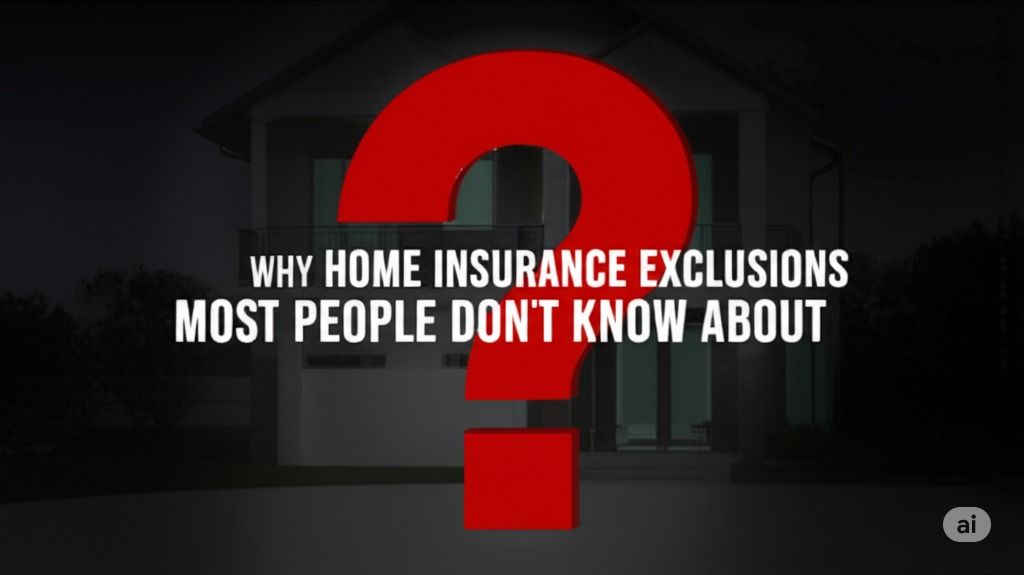Common Home Insurance Exclusions Most People Don’t Know About
🏠 Introduction
Home insurance gives homeowners peace of mind, protecting their property and belongings from various risks. But did you know that not everything is covered by a standard home insurance policy?
Many homeowners are shocked when their claims are denied—often because they weren’t aware of the exclusions hidden in the fine print. In 2025, with climate events, rising theft, and cyber risks, understanding what isn’t covered is just as important as knowing what is.
In this post, we’ll uncover the most common home insurance exclusions that most people don’t know about—and how you can fill those coverage gaps.
🔍 What Are Home Insurance Exclusions?
Exclusions are specific situations or types of damage that your insurance will not cover. These exclusions are listed in your policy document and vary by provider, location, and plan.
Insurance companies use exclusions to limit their risk. That’s why it’s crucial to read your policy carefully or speak to your insurer about what’s not covered.
⚠️ 1. Flood Damage
Standard home insurance does not cover flood damage caused by heavy rain, overflowing rivers, or storm surges.
- If you live in a flood-prone area, you’ll need to purchase separate flood insurance.
- Even a few inches of water can cause thousands in damage, so this is a critical gap.
Tip: Inquire about government-supported flood insurance schemes or add-ons from private insurers.
⚠️ 2. Earthquake and Ground Movement
Damage from earthquakes, landslides, sinkholes, and soil erosion is usually excluded from standard policies.
- In high-risk regions, you must add a seismic or earthquake rider.
- This includes structural damage, foundation cracks, and even broken pipes due to tremors.
Tip: Many insurers offer earthquake coverage as an affordable add-on—don’t skip it if you live near fault lines.
⚠️ 3. Wear and Tear or Lack of Maintenance
Insurance is designed to protect you from sudden and accidental damage, not gradual deterioration.
- Common examples: Leaking roofs due to age, mold buildup, rusting pipes, termite damage.
- If damage occurs due to poor upkeep or neglect, it’s your responsibility, not the insurer’s.
Tip: Keep up with regular home maintenance to avoid uncovered losses.
⚠️ 4. Pest or Vermin Infestations
Most policies exclude damage caused by:
- Termites
- Rats or mice
- Cockroaches
- Bed bugs
Insurers view these as preventable through regular pest control, so claims for repairs caused by pests are typically denied.
Tip: Schedule routine pest inspections to protect your home proactively.
⚠️ 5. Intentional Damage
If you, a household member, or someone you hired intentionally damages your home, it’s not covered.
This includes:
- Arson committed by a homeowner
- Malicious damage by tenants (unless you have landlord insurance)
- Fraudulent or exaggerated claims
Tip: Always be honest during the claims process. Insurance fraud is a criminal offense.
⚠️ 6. Business Equipment and Home Office Use
With more people working from home in 2025, this is an emerging issue.
- Home insurance usually limits coverage for business-related equipment (e.g., laptops, printers, stock).
- Claims for business liability or loss of income are also excluded.
Tip: Ask your insurer about home office endorsements or consider a separate business insurance policy.
⚠️ 7. High-Value Items Above Policy Limits
Standard policies may cap coverage on:
- Jewelry
- Art
- Collectibles
- Musical instruments
- Cash
If these items exceed the policy limit, you’ll be reimbursed only up to the capped amount—not their full value.
Tip: Schedule high-value items separately with a personal property rider or endorsement.
⚠️ 8. Acts of War or Nuclear Events
Damage from wars, invasions, or nuclear incidents is universally excluded by all insurers.
While rare, it’s worth noting that:
- Civil unrest and terrorism may be excluded or require special coverage.
- Some insurers now offer terrorism coverage add-ons, especially in high-risk zones.
⚠️ 9. Power Failure and Data Loss
Damage resulting from power outages or electrical failures not caused by a covered peril is generally not included.
Also:
- Data loss on smart devices, computers, or home servers is not covered.
- Home automation and IoT failures are new but increasingly common exclusions.
Tip: If you rely heavily on tech, ask about electronics or cyber add-ons.
⚠️ 10. Government Action or Property Seizure
If the government seizes, demolishes, or restricts access to your property, your home insurance won’t cover losses caused by such action.
Examples:
- Eminent domain
- Legal confiscation
- Government-led demolition due to zoning violations
💡 How to Deal with Exclusions
To protect yourself from these coverage gaps:
- Read your policy word-by-word. Don’t rely on assumptions.
- Ask your insurer about anything unclear.
- Get additional coverage or riders based on your needs.
- Bundle policies to save on premium costs for optional protections.
📝 Checklist: What to Ask Your Insurer
- Does this policy cover flood, earthquake, or storm surge damage?
- What are the limits on jewelry, electronics, or collectibles?
- Will this cover my home office or remote work equipment?
- What happens if mold or termites cause damage?
- Can I get optional riders for excluded events?
🏁 Conclusion
Home insurance is a powerful safety net—but only if you know what’s excluded. In 2025, it’s more important than ever to understand your coverage and plug any dangerous gaps.
By being proactive and informed, you’ll avoid nasty surprises during claims and truly protect what matters most—your home and your peace of mind.

